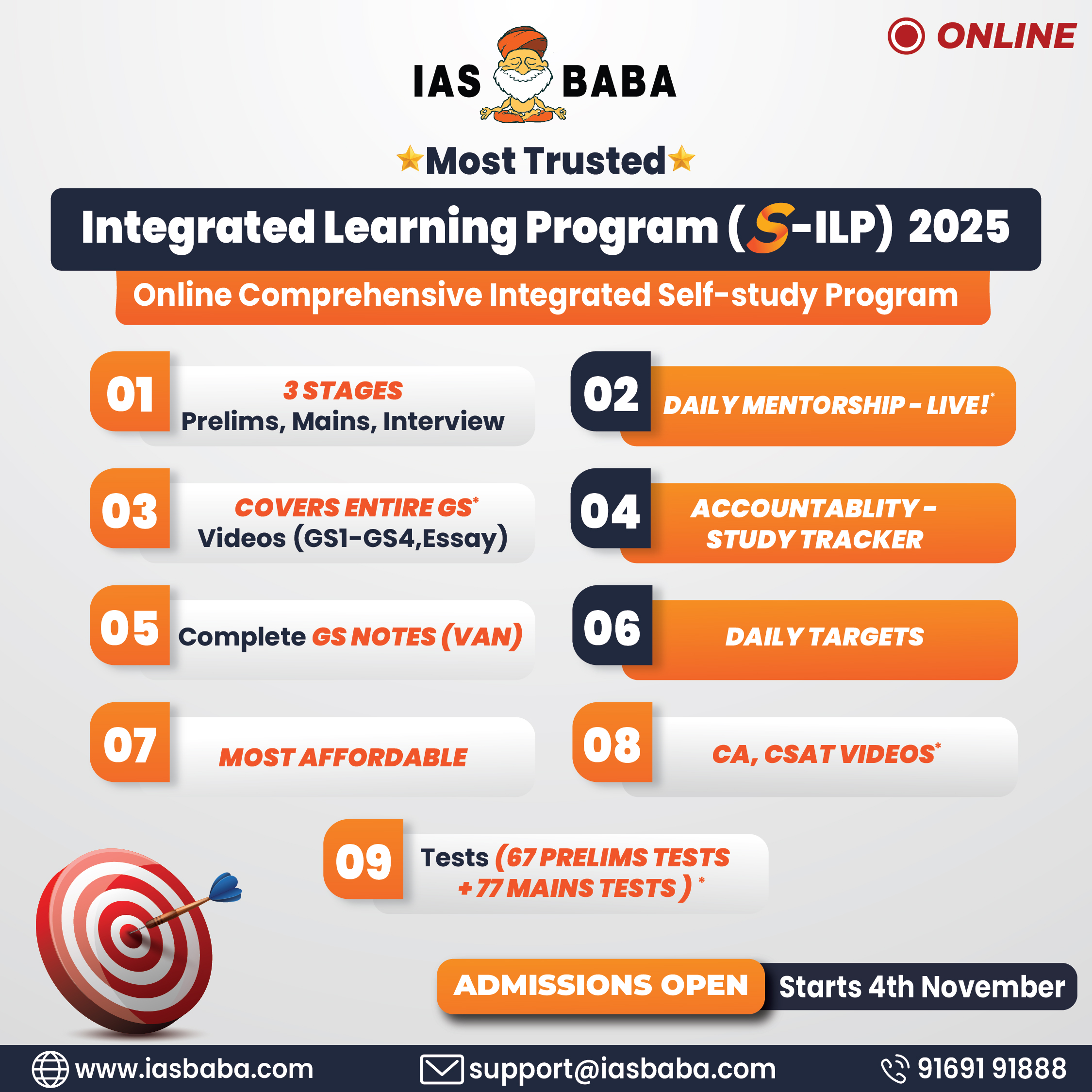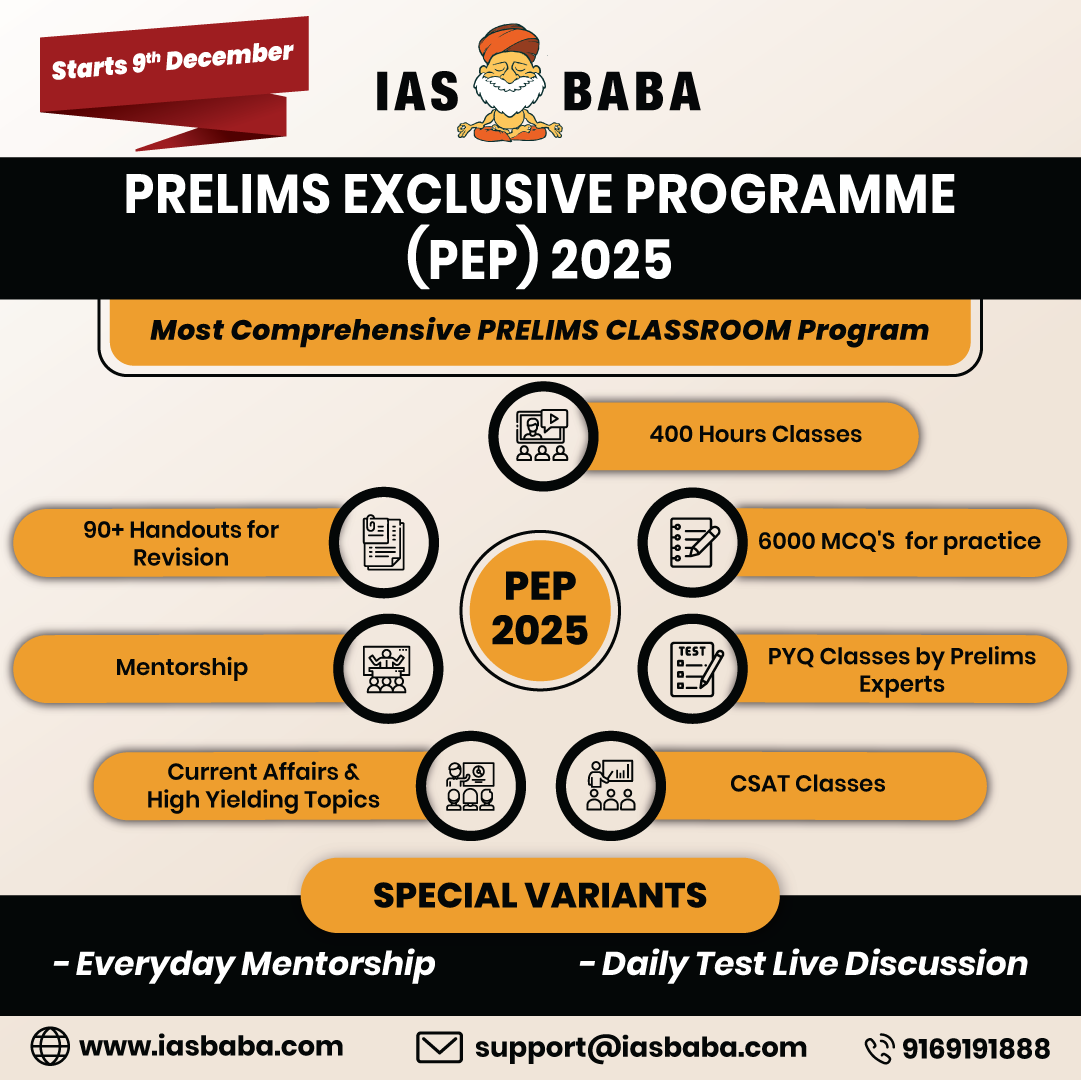IASbaba's Daily Current Affairs Analysis
Archives
(PRELIMS & MAINS Focus)
Syllabus
- Prelims & Mains – CURRENT EVENT
Context: IMD issued ‘red alert’ in Gujarat due to heavy rainfall and severe waterlogging.
Background: –
- India Meteorological Department (IMD) issues colour-coded weather alerts from time to time. These keep citizens informed and help in greater preparedness
About colour coded warnings
- ‘Green’ stands for ‘No warning’: no action needs to be taken by the authorities, and the forecast is of light to moderate rain. According to the weather department, 15.6 mm to 64.4 mm rain is considered “moderate”.
- ‘Yellow’ alert signifies “Watch”, and authorities are advised to “Be updated” on the situation. According to the weather department, 64.5 mm to 115.5 mm rain is considered “heavy”.
- ‘Orange’ warning stands for “Alert”, and authorities are expected to “Be prepared”. The forecast during an Orange warning is of heavy to very heavy rainfall. According to IMD, 115.6 mm to 204.4 mm rain is considered “very heavy”.
- ‘Red’ alert stands for “Warning”, and asks authorities to “Take action”. The forecast is for extremely heavy rainfall. According to IMD, more than 204.5 mm rain is considered “extremely heavy”.
Additional Information
- India’s weather forecasting capabilities are set for a major upgrade with a new mission, boasting a budget of at least Rs 10,000 crore.
- This initiative will surpass the Monsoon Mission launched in 2012, which significantly enhanced the India Meteorological Department’s (IMD) infrastructure and capabilities.
- Unlike previous upgrades that concentrated on infrastructure improvements, the new mission will focus on developing advanced computer simulation models tailored for India and incorporating climate change scenarios.
- It will also enhance the deployment of sophisticated instruments such as Doppler radars and integrate artificial intelligence and machine learning into weather forecasting.
- India currently operates three meteorological satellites—INSAT-3D, INSAT-3DR, and INSAT-3DS. With INSAT-3D and INSAT-3DR nearing the end of their mission lives, and INSAT-3DS recently launched, the next-generation INSAT-4 series satellites are in development. These new satellites will feature cutting-edge technology for high-resolution data essential for improving weather forecasts.
Source: Indian Express
Syllabus
- Mains GS-2
Context: India and the US have signed a Security of Supply Arrangement (SOSA) and Memorandum of Agreement regarding the Assignment of Liaison Officers.
Background: –
- Defence Minister Rajnath Singh concluded his four-day official visit to US on August 25.
Key takeaways:
- During Defence Minister Rajnath Singh’s recent four-day visit, India and the US agreed to advance key co-production projects under the 2023 US-India Roadmap for Defence Industrial Cooperation. These projects include jet engines, unmanned platforms, munitions, and ground mobility systems.
Two new agreements
- SOSA (Support for One Another):
- Under SOSA, the US and India will provide reciprocal priority support to each other for goods and services that promote national defence.
- It will enable both countries to acquire the industrial resources they need from one another to resolve unanticipated supply chain disruptions to meet national security needs.
- India becomes the 18th partner in this initiative. While SOSA is a significant mechanism for strengthening interoperability with US defense trade partners, it is non-binding.
- US Department of Defense (DoD) has been working to conclude another agreement with India, the Reciprocal Defence Procurement (RDP) Agreement, which will be binding.
- MoU on Liaison Officers:
- The new Memorandum of Agreement on the Assignment of Liaison Officers builds on a previous decision to enhance information-sharing between India and the US.
- This agreement will see Indian armed forces officers posted to key US Commands, starting with the deployment of a Liaison Officer to the US Special Operations Command headquarters in Florida.
- The roadmap for defence industrial cooperation, released last year, anticipated the completion of SOSA and the RDP Agreement.
- Additionally, the US-India initiative on Critical and Emerging Technology (iCET), aims to expand strategic technology partnerships and defense industrial cooperation.
- In 2023, during Prime Minister Modi’s official visit to the US, the DoD and Ministry of Defence launched the India-US Defence Acceleration Ecosystem (INDUS-X), to take forward the commitment to build a defence innovation bridge under iCET.
Additional Information:
- In 2002, India and the US signed the General Security of Military Information Agreement (GSOMIA) to facilitate military information sharing. Four more agreements were signed between 2016 and 2020.
- In 2016, the US designated India as a Major Defence Partner. This status led to India’s elevation to Strategic Trade Authorisation Tier 1 in 2018, granting it license-free access to various military and dual-use technologies regulated by the US Department of Commerce.
- The Logistics Exchange Memorandum of Agreement (LEMOA) of 2016 established the framework for reciprocal logistic support, supplies, and services between the two militaries.
- In 2018, the Communications Compatibility and Security Agreement (COMCASA), an India-specific version of the CISMOA, was signed to secure military communications and facilitate the use of advanced US defense systems by India.
- The Basic Exchange and Cooperation Agreement (BECA) of 2020 was designed to facilitate the sharing of military information, including maps, nautical charts, and other unclassified data.
Source: Indian Express
Syllabus
- Prelims: CURRENT EVENT
Context: Indian Space Research Organisation (ISRO) finalises the design of skull for the humanoid on Gaganyaan mission.
Background: Before launching astronauts on the Gaganyaan mission, ISRO will send a humanoid robot, Vyommitra, into space to test spacecraft safety.
Key takeaways
- The humanoid’s skull, designed at ISRO’s Thiruvananthapuram unit, weighs 800 grams and measures 200 mm x 220 mm, made from a high-strength aluminum alloy to endure pressure and vibration.
- Vyommitra will resemble the upper human body, featuring movable arms, face, and neck equipped with sensors to perform human-like functions and assess the impacts of space travel.
- Ahead of putting an actual human into space, several studies are done using humanoids. They collect vital data on the impacts of space travel on human bodies, enabling scientists to design the space capsule for a safe and comfortable flight.
- India’s Gaganyaan mission, aimed at sending humans into space, is slated for next year. Before this, two uncrewed preparatory missions—Gaganyaan-1 (G1) and Gaganyaan-2 (G2)—will be conducted, with G1 scheduled for December.
- G1 will primarily test the spacecraft’s safe re-entry and orientation upon splashing down at sea. G2 will carry the robot Vyommitra inside the human-rated crew module to simulate astronaut conditions and record flight parameters for human impact studies.
- The main Gaganyaan mission will launch three Indian astronauts into space, about 400 km above Earth, for a three-day mission.
Additional Information
- The Gaganyaan mission is India’s first manned space flight that is currently scheduled for next year.
- Only three countries — the United States, Russia and China — have sent human spaceflights till now, though over 600 astronauts, including over 70 women, from close to 50 different countries have gone into space.
- The Indian Space Research Organisation (ISRO) had started planning for a human spaceflight mission way back in 2004 but the real possibilities opened up only after the success of Chandrayaan and Mangalyaan missions, and the development of the GSLV rocket in the last one decade.
- The Gaganyaan mission was originally scheduled for a launch in 2022, to coincide with 75 years of India’s independence, but that schedule got derailed because of the Covid pandemic.
Source: Indian Express
Syllabus
- Prelims – GEOGRAPHY
Context: The Atacama salt flat in Chile is experiencing subsidence due to lithium mining.
Background: According to a study by the University of Chile, the salt flat is sinking at a rate of 1 to 2 centimeters (0.4 to 0.8 inches) annually because of lithium brine extraction.
About Lithium
- Lithium (symbol: Li) is a chemical element with atomic number 3.
- It belongs to the alkali metal group and is highly reactive.
- Lithium Triangle held approximately 54% of the world’s lithium reserves.
- The Lithium Triangle spans the southwestern corner of South America. It encompasses parts of Argentina, Bolivia, and Chile.
- Lithium is found in various forms, including minerals, brines, and ores.
- The Atacama salt flat in Chile is a significant source of lithium due to its high lithium content in brine. Brine extraction involves pumping salt-rich water to the surface, where it evaporates in ponds, leaving behind concentrated lithium salts.
Environmental impact of lithium mining in the Atacama region:
- Water Scarcity:
- Brine Evaporation Method: In the Atacama Desert, miners extract lithium from brines found beneath salt flats. This method is highly water-intensive.
- Massive Ponds: Miners pump salty lithium-containing water (brine) into massive ponds, where it takes years for the evaporation process to separate the lithium.
- Scarce Water Resources: Unfortunately, this technique drains already scarce water resources, exacerbating the region’s water crisis.
- Community Hardships:
- Privatization of Minerals and Water: A legacy of the Pinochet era in Chile is the privatization of minerals and water. Companies have ownership rights over these resources.
- Access to Potable Water: As mining operations intensify, communities lose access to potable water. They now rely on water tankers for survival.
- Ecological Impacts:
- Native Species: Around 80% of the salt flats’ animal species are native. The region is critical for migratory birds. Reduced water levels affect species like flamingos.
- Wetlands Damage: The mining process harms wetlands, affecting ecosystems and wildlife.
- Chemical Contamination: Sulfuric acid and sodium hydroxide used in extraction can contaminate soil and water.
Source: Reuters
Syllabus
- Prelims – CURRENT EVENT
Context: India has successfully launched its first reusable hybrid rocket, RHUMI-1.
Background: The launch took place from Thiruvidandhai in Chennai.
About RHUMI- 1
- RHUMI-1 is India’s first reusable hybrid rocket, launched by a Tamil Nadu-based startup called Space Zone India.
- The mission is led by Anand Megalingam from Space Zone India under the guidance of Dr. Mylswamy Annadurai, former Director of ISRO Satellite Centre (ISAC).
- It is capable of reaching altitudes between 1km and 500km.
Mission Objectives:
- The rocket carried three CUBE satellites, designed to monitor atmospheric conditions such as cosmic radiation intensity, UV radiation, and air quality.
- Additionally, it deployed 50 Pico satellites to investigate various atmospheric factors, including accelerometer readings, altitude, and ozone levels, contributing to our understanding of environmental dynamics.
Hybrid Propulsion System:
- RHUMI-1 stands out for its innovative hybrid propulsion system, which combines the advantages of both liquid and solid fuels.
- This technology promises improved efficiency and reduced operational costs, making space exploration more accessible.
Ecofriendly feature:
- RHUMI-1 is equipped with a CO2-triggered parachute system. This is an eco-friendly and cost-effective method that ensures the safe recovery of rocket components post-launch.
- Beyond space exploration, the applications of RHUMI-1 extend to sectors like agriculture, disaster management, and environmental monitoring.
Environmental Impact:
- RHUMI-1’s reusability reduces the financial burden of space exploration and minimizes its environmental impact.
Source: New Indian Express
Syllabus
- Prelims : CURRENT EVENT
Context: Recently, there has been a sharp increase in Acute Encephalitis Syndrome (AES) cases in Gujarat.
Background: Ahmedabad city alone has reported 12 AES cases, with half of them resulting in fatalities. Health officials are closely monitoring the situation, and measures are being taken to manage and investigate the outbreak.
About Acute Encephalitis Syndrome (AES)
- Acute Encephalitis Syndrome (AES) is a severe form of encephalitis caused primarily by mosquito-borne viruses, characterized by high fever and brain inflammation.
- Acute Encephalitis Syndrome is an umbrella term used for infections that cause inflammation, irritation, or swelling in the brain.
- It is characterized by an acute onset of fever and clinical neurological manifestations such as mental confusion, disorientation, delirium, convulsions, or coma.
- AES can be caused by Japanese encephalitis virus (JEV) or other infectious and non-infectious factors.
- Encephalitis can sometimes lead to death.
- Getting diagnosed and treated right away is important because it’s hard to predict how encephalitis may affect each person.
Causes of encephalitis:
- When inflammation is caused by an infection in the brain, it is known as infectious encephalitis. And when it is caused by the immune system attacking the brain, it known as autoimmune encephalitis. Sometimes there is no known cause.
- World Health Organisation (WHO) introduced the term AES to denote a group of similar diseases.
How can AES be prevented?
- Vaccination
- Proper sanitation facilities
- Increasing access to safe drinking water.
- Improve the nutritional status of children who are at risk of AES
- Preventive measures should be directed at reducing the overall mosquito density. Personal protection against mosquito bites by using mosquito nets that are treated with insecticide is recommended. Other methods like wearing fully covered, loose-fitting clothes or use of repellents, etc. need to be adopted to avoid mosquito bites.
- The transmission risk increases when animal sheds (especially piggeries) and human dwellings are situated very close to each other.
Vaccination:
- As per the guidelines of the Government of India, two doses of the JE/AES vaccine have been approved to be given. One with the measles vaccine at 9 months of age and the second with the DPT booster at 16-24 months of age.
Source: WHO
Practice MCQs
Q1.) Consider the following countries:
- Argentina
- Bolivia
- Chile
- Venezuela
How many of the above-mentioned countries are the part of lithium triangle?
- Only one
- Only two
- Only three
- All four
Q2.) With reference to the RHUMI-1, consider the following statements:
- RHUMI-1 is India’s first reusable hybrid rocket launched by ISRO.
- The rocket carried three CUBE satellites, designed to monitor atmospheric conditions such as cosmic radiation intensity, UV radiation, and air quality.
- Its hybrid propulsion system combines the advantages of both liquid and solid fuels.
How many of the statements given above are correct?
- Only one
- Only two
- All three
- None
Q3.) With reference to the Acute Encephalitis Syndrome (AES), consider the following statements:
- It is a severe form of encephalitis caused primarily by mosquito-borne viruses, characterized by high fever and brain inflammation.
- When inflammation is caused by an infection in the brain, it is known as infectious encephalitis.
Which of the statements given above is /are not correct?
- 1 only
- 2 only
- Both 1 and 2
- Neither 1 nor 2
Comment the answers to the above questions in the comment section below!!
ANSWERS FOR ’ 28th August 2024 – Daily Practice MCQs’ will be updated along with tomorrow’s Daily Current Affairs
ANSWERS FOR 27th August – Daily Practice MCQs
Q.1) – b
Q.2) – c
Q.3) – d











